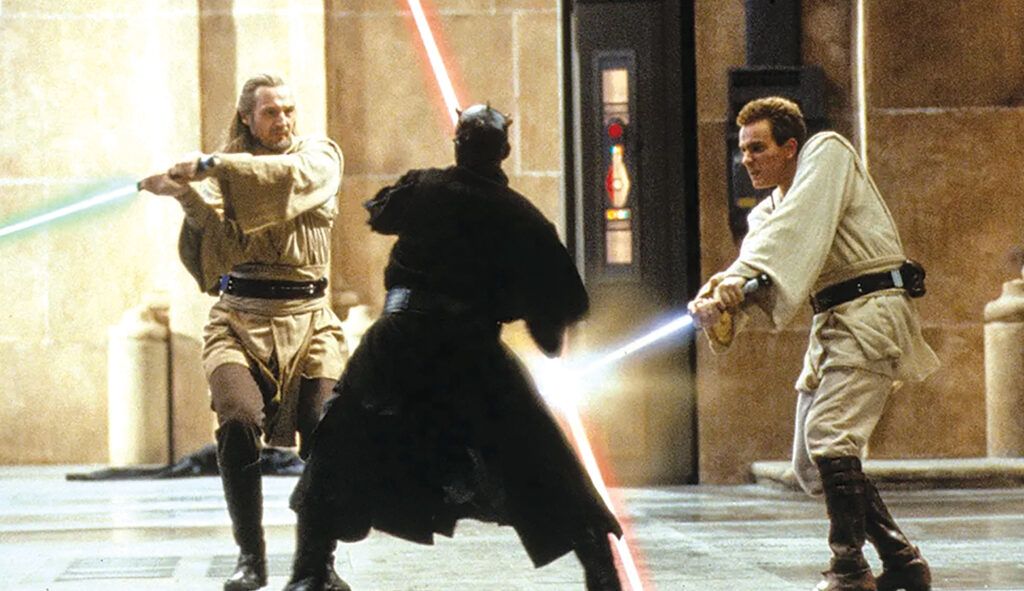
In celebration of the 25th anniversary of the release of Star Wars: Episode I: The Phantom Menace this month, the film has returned to theaters. And at the behest of the editors of this magazine, I returned to theaters to watch it on the big screen once again, as I did for its 20th anniversary five years ago.
The Star Wars prequels — that is, Episode I: The Phantom Menace, along with Episode II: Attack of the Clones and Episode III: Revenge of the Sith — represent something of a generational yardstick for me and my fellow millennials. Each anniversary milestone it hits, we are reminded of how old we were then, how old we are now, and the ever-growing gulf between those ages and times. Each generation has these cultural yardsticks, of course. Every parent has heard how old and lame his or her music is, how bygone and forgotten his or her starlets or athletes.

(LucasFilm/Allstar)
One of the oddities of The Phantom Menace, however, is it seems to age and change right along with us. When I last watched and reviewed the movie for this magazine, the prequels were enjoying something of a renaissance of appreciation. In between the releases of Star Wars: Episode VIII: The Last Jedi and Star Wars: Episode IX: The Rise of Skywalker, fans and audiences were realizing the much-maligned origin story movies George Lucas had returned to tell were not, in fact, as bad as it could get for Star Wars, and perhaps the prequels were better than we had all collectively decided they were. While that second return of Star Wars to the big screen engendered some rosy reflection, five years on, there has been nothing but “new” Star Wars. Gone are the times of “when they seldom come, they wished-for come.” Star Wars has ceased to be an exciting and infrequent visitor and fully moved into the media landscape, leaving its toothbrush and beard trimmings on the sink. And like a friend crashing on the couch well beyond the weekend, I’d much rather it take its stuff and leave already.
Perhaps due to the series’s oversaturation, perhaps due to my increasing age, I found The Phantom Menace a much worse film than I left it. The biggest problem with the film (even more so than the dialogue) is its pacing and structure. Whereas the original trilogy traces the hero’s journey through the progression of Luke Skywalker, The Phantom Menace lacks any true protagonist. Anakin Skywalker, whose fall into the Dark Side is central to the story of the prequels, does not appear in Episode I until past the 40-minute mark. Characters with the most screen time, such as Liam Neeson’s Qui-Gon Jinn, Ahmed Best’s Jar Jar Binks, and Natalie Portman’s Queen Padmé Amidala, are impactful to the plot but mostly static, with little to no character development in terms of arc or personal growth. And though Ewan McGregor’s Obi-Wan Kenobi does have something resembling character progression, he is shunted off-screen for most of the movie. One could reasonably argue that the protagonist is actually Sheev Palpatine (yes, that’s his first name), who goes from scheming Naboo senator to Chancellor of the Galactic Republic, all while secretly being the evil Sith Lord pulling the strings. But most of his machinations are naturally happening in the background.
The Phantom Menace is left with something of a jumbled mess lacking any real anchor. This results in some truly odd pacing, as the movie rushes through quick, choppy scenes in the first act, relying on only the most perfunctory dialogue, just to languish in distractions in Act 2. Act 3 wraps everything up in a finale consisting of four concurrent but separate battlefields, as we jump from lightsaber duel to palace infiltration, to the robot battle front lines, to Anakin saving the day in a space battle above the planet. As Lucas famously remarked, sunken-faced, when watching a test screening of the movie’s final act, “I may have gone too far in some places.”
While the film is not “good” by any means, it is not altogether bad. The John Williams score throughout remains fantastic. The climactic “Duel of the Fates” is among the composer’s best work. Episode I also boasts the best lightsaber fight in the whole series, which counts for something. More importantly, however, I find The Phantom Menace much better than what has come after. Trade disputes leading to the destruction of a sclerotic senate, its grubby bureaucrats, and arrogant overseers might strike general audiences as a bit dry for a series with “Star” and “War” in the title, but at least Lucas was telling his original story for the purpose of telling that story. He was not sifting through someone else’s work to cash in on the easy intellectual property recognition for the sake of more. Which is what we have now.
CLICK HERE TO READ MORE FROM THE WASHINGTON EXAMINER
With the singular exception of Andor and one-half season of The Mandalorian, Disney Star Wars has been a colossal failure of both vision and execution, pilfering the successes of the past to jangle “remember this” keys in front of a diminishing audience. Little wonder Disney has failed to turn a profit on its purchase of the franchise when “a galaxy far, far away” keeps seeming to tell less and less coherent stories about the less and less interesting periphery of the same core story.
The state of Star Wars is representative of the state of Marvel, of Lord of the Rings, of every live-action remake or gender-swapped blockbuster redo, of film and television writ large: More of the same, over and over, a culture composting itself without end. As Kylo Ren says unheeded in one of the forgettable, innumerable new Star Wars movies, in advice the Disney bosses ought to take to heart before greenlighting another live-action Lion King or another episode of Skywalker family drama — or, for that matter, another theatrical release of The Phantom Menace in five years — “Let the past die. Kill it, if you have to.” If only.
Grant Addison is a deputy editor for the Washington Examiner magazine.







